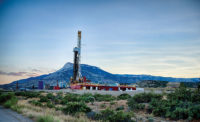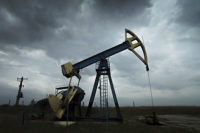The danger arrives with trucks bearing tons of sand. Off-loading that sand – which may contain up to 99 percent silica – can send clouds of thick dust into the air, exposing the lungs of fracking workers who are performing the task to serious inhalation hazards.
More risk is generated during the fracking process itself. During this method of harvesting natural gas, holes are drilled deep into the earth and a mixture of water, sand and chemicals is blasted at high pressures in order to fracture the shale rock formations thousands of feet underground and release the gas from the head of the well. Fracking – also known as hydraulic fracturing — potentially exposes workers to respiratory risks in the form of hydrogen sulfide and silica.
From headaches to death
Hydrogen sulfide is a flammable, colorless gas that is toxic at extremely low concentrations. It smells like “rotten eggs” and can quickly cause someone to lose their sense of smell. Adding to its danger: pockets of the gas can occur anywhere. Depending on the exposure level, inhaling hydrogen sulfide can result in symptoms ranging from headaches, nausea, eye irritation, and respiratory tract irritation to pulmonary edema and death.1
Silica is a naturally occurring mineral composed of sand, rock and mineral ores. Exposure to silica can cause lung cancer, chronic obstructive pulmonary disease, kidney disease and silicosis, which scars and stiffens the lungs, making it increasingly difficult to breathe and causing disability and, often, a shortened lifespan.2
Silica’s dire effects have earned it a Hazard Alert2 from OSHA and NIOSH and, more recently, a final rule3 that sharply reduced the permissible exposure limit (PEL) for the substance.
Protecting workers
Employers are responsible for determining which jobs expose workers to silica and for taking actions to control overexposures and protect workers.
NIOSH has made the first task a bit easier by identifying sand mover and blender operators and workers downwind of these operations (especially during hot loading) as having the highest silica exposures. Workers upwind and not in the immediate area of sand movers (sand delivery truck spotters) also had exposures above the NIOSH Recommended Exposure Limit (REL), possibly from the dust created by traffic at the well site. Worker and area samples collected in enclosed but non-filtered cab vehicles (e.g., chemical and blender trucks) were above the REL, even when spending most of the day in the cab.2
Protecting workers from silica, according to OSHA and NIOSH, can be accomplished through a combination of engineering controls, work practice, protective equipment, and product substitution (where feasible), along with worker training.
PPE requirements
When engineering and work practices controls are not feasible or don’t reduce silica exposures below OSHA PELs, employers must provide workers with NIOSH-approved N95 respirators. If the silica level is more than 10 times the PEL, a half-face respirator is not protective and a respirator that offers a greater level of protection (e.g., a full-facepiece respirator, which will protect workers at silica levels up to 50 times the PEL) must be used. Full-face powered air-purifying respirators (PAPR) provide more protection than half-face air-purifying respirators. In general, workers find PAPRs to be more comfortable.2
Whenever respirators are used, the employer must have a respiratory protection program in place that meets the requirements of OSHA’s Respiratory Protection Standard (29 CFR 1910.134).4 This program must include proper respirator selection, fit testing, medical evaluations, and training.



